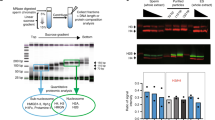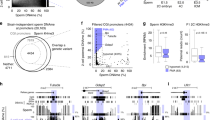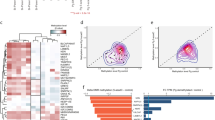Abstract
Preferential paternal X–inactivation in the extra–embryonic tissues of the female mouse embryo is correlated with imprinted expression of the paternal allele of the Xist gene in pre–implantation development. Here we examine 11 CpG sites in Xist to determine whether differential methylation might be the molecular basis for imprinting. We find that three sites in the promoter region are methylated in eggs but not in sperm and that this differential methylation is maintained to the blastocyst stage when the paternal X–inactivation occurs. This is the first example of a primary gametic methylation imprint governing differential expression of parental alleles in pre–implantation embryos.
This is a preview of subscription content, access via your institution
Access options
Subscribe to this journal
Receive 12 print issues and online access
$209.00 per year
only $17.42 per issue
Buy this article
- Purchase on Springer Link
- Instant access to full article PDF
Prices may be subject to local taxes which are calculated during checkout
Similar content being viewed by others
References
Lyon, M.F. Gene action in the X chromosome of the mouse (Mus musculus L.). Nature 190, 373 (1961).
Grant, M., Zuccotti, M. & Monk, M. Methylation of CpG sites of two X-linked genes coincides with X-inactivation in the female mouse embryo but not in the germ line. Nature Genet. 2, 161–166 (1992).
Brown, C.J. et al. A gene from the region of the X-inactivation center is expressed exclusively from the inactive X chromosome. Nature 349, 38–44 (1991).
Brockdorff, N. et al. Conservation of position and exclusive expression of mouse Xist from the inactive X chromosome. Nature 351, 329–331 (1991).
Kay, G.F., Barton, S.C., Surani, M.A. & Rastan, S. Imprinting and X chromosome counting mechanisms determine Xist expression in early mouse development. Cell 77, 639–650 (1994).
Monk, M. & Harper, M. Sequential X-chromosome inactivation coupled with Cellular differentiation in early mouse embryos. Nature 281, 311–313 (1979).
Takagi, N. & Sasaki, M. Preferential expression of the paternally derived X chromosome in the extraembryonic membranes of the mouse. Nature 256, 640–642 (1975).
West, J.D., Frels, W.I., Chapman, V.M. & Papaioannou, V.E. Preferential expression of the maternally derived X chromosome in the mouse yolk sac. Cell 12, 873–882 (1977).
Harper, M.I., Fosten, M. & Monk, M. Preferential paternal X inactivation in extraembryonic tissues of early mouse embryos. J. Embryol. exp. Morph. 67, 127–135 (1982).
Kay, G.F. et al. Expression of Xist during mouse development suggest a role in the initiation of X chromosome inactivation. Cell 72, 171–182 (1993).
Norris, D.P. et al. Evidence that random and imprinted expression is controlled by preemptive methylation. Cell 77, 41–51 (1994).
Singer-Sam, J. et al. DNA methylation in the 5′ region of the mouse Pgk-1 gene and a quantitative PCR assay for methylation. In UCLA Symposia on Molecular and Cellular Biology 128 (eds Clawson, G. et al.) (Alan R. Liss, New York, (1989).
Singer-Sam, J. et al. Use of an HpaII-polymerase chain reaction assay to study DNA methylation at the PgK-1 CpG island of mouse embryos at the time of X-chromosome inactivation. Molec. Cell. Biol 10, 4987–4989 (1990).
Monk, M., Boubelik, M. & Lehnert, S. Temporal and regional changes in DNA methylation in the embryonic, extraembryonic and germ Cell lineages during mouse embryo development. Development 99, 371–382 (1987).
Razin, A. & Cedar, H. DNA methylation and genomic imprinting. Cell 77, 473–476 (1994).
Monk, M. Methylation and the X chromosome. BioEssays 4, 204–208 (1986).
Grant, S. & Chapman, V. Mechanisms of X-chromosome inactivation. M. A. Rev. Genet. 22, 199–233 (1988).
Kafri, T. et al. Developmental pattern of gene-specific DNA methylation in the mouse embryo and germ line. Genes Dev. 6, 705–714 (1992).
McCarrey, J.R. & Dilworth, D.D. Expression of Xist in mouse germ Cells correlates with X-chromosome inactivation. Nature Genet. 2, 200–203 (1992).
Salido, E.D., Yen, P.H., Mohandas, T.K. & Shapiro, L.J. Expression of the X-inactivation-associated-gene Xist during spermatogenesis. Nature Genet. 2, 196–199 (1992).
Brandeis, M. et al. The ontogeny of allele-specific methylation associated with imprinted genes in the mouse. EMBO J. 12, 3669–3677 (1993).
Glenn, C.C., Porter, K.A., Jong, M.T.C., Nicholls, R.D. & Driscoll, D.J. Functional imprinting and epigenetic modification of the human SNRP gene. Hum. molec. Genet. 2, 2001–2005 (1993).
Sutcliffe, J.S. et al. Deletions of differentially methylated CpG island at the SNPP gene define a putative imprinting control region. Nature Genet. 8, 52–58 (1994).
Stoger, R. et al. Maternal-specific methylation of the imprinted mouse Igf2r locus identifies the expressed locus as carrying the imprinted signal. Cell 73, 61–71 (1993).
Bartoiomei, M.S., Webber, A.L., Brunkov, M.E. & Tilghman, S.M. Epigenetic mechanisms underlaying the imprinting of the mouse H19 gene. Genes Dev. 7, 1663–1673 (1993).
Ferguson-Smith, A.C., Sasaki, H., Cattanach, B.M. & Surani, M.A. Parental-origin-speciflc epigenetic modification of the mouse H19 gene. Nature 362, 751–755 (1993).
Chaillet, J.R., Vogt, T.F., Beier, D.R. & Leder, P. (1991). Parental-specific methylation of an imprinted transgene is established during gametogenesis and progressively changes during embryogenesis. Cell 66, 77–83 (1991).
Monk, M. (ed.) Mammalian Development – practical Approach (IRL Press, Oxford, (1987).
Reik, W., Collick, A., Norris, M.L., Barton, S.C. & Surani, M.A., Genomic imprinting determines methylation of parental alleles in transgenic mice. Nature 328, 248–251 (1987).
Zuccotti, M., Grant, M. & Monk, M. Polymerase chain reaction for the detection of methylation of a specific CpG site in the G6pd gene of mouse embryos. Meth. Enzymol. 225, 557–567 (1993).
Brockdorff, N. et al. The product of the mouse Xist gene is a 15 Kb Inactive X-specific transcript cointaining no conserved ORF and located in the nucleus. Cell 71, 515–526 (1992).
Author information
Authors and Affiliations
Rights and permissions
About this article
Cite this article
Zuccotti, M., Monk, M. Methylation of the mouse Xist gene in sperm and eggs correlates with imprinted Xist expression and paternal X–inactivation. Nat Genet 9, 316–320 (1995). https://doi.org/10.1038/ng0395-316
Received:
Accepted:
Issue Date:
DOI: https://doi.org/10.1038/ng0395-316
This article is cited by
-
High-resolution analysis of germ cells from men with sex chromosomal aneuploidies reveals normal transcriptome but impaired imprinting
Clinical Epigenetics (2019)
-
No imprinted XIST expression in pigs: biallelic XIST expression in early embryos and random X inactivation in placentas
Cellular and Molecular Life Sciences (2019)
-
Development and imprinted gene expression in uniparental preimplantation mouse embryos in vitro
Molecular Biology Reports (2015)
-
Fetal exposure to bisphenol A affects the primordial follicle formation by inhibiting the meiotic progression of oocytes
Molecular Biology Reports (2012)
-
Regulation of X-chromosome inactivation by the X-inactivation centre
Nature Reviews Genetics (2011)



